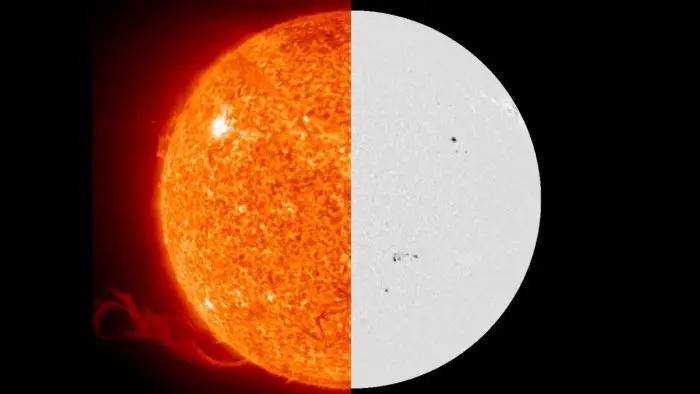In a short and direct answer: the sun’s light and color is white.
You may have heard about the light spectrum that we can see with the human eye being white light. This is because they all come together to form white light.
Since we can see the range of seven colors of light in the outside world, it follows that the sun must be able to emit all of the seven colors of the rainbow. The sun emits all of these colors relatively evenly and so the overall effect is a white color.
We can see evidence of this in the fact that if the sun only emitted blue light, everything on Earth would appear blue, as if we were looking through blue-tinted glasses.
Another solid piece of evidence to show this is that when a rainbow forms in nature, this is the sun’s light being refracted and reflected through rain droplets. The rainbow shows all seven colors of the light spectrum, and thus, this means that the sun must emit white light and therefore be the color white.

We mentioned that the colors of the visible spectrum are emitted ‘relatively’ evenly. This is because there may be some fluctuations. As a result of this, a lot of researchers and scientists have taken to finding the sun’s brightest color, or its peak frequency. They do this with the desire to discover the ‘real’ color of the sun.
The main issue with this sort of definition of the sun’s color is that the peak frequency can change depending on some factors. The main factor being that this peak frequency measurement will change depending on if it is taken in frequency space or wavelength space. The wavelength of light is the measurement of the distance between two wave crests, and the frequency measurement is the number of waves that pass through a point in one second.
Given this information, it follows that the measurements will appear different for the two. If we take the peak frequency from a wavelength graph, the peak is in the violet section of visible light. But if we take the peak frequency to be the measurement from the frequency graph, the peak lies in infrared.
These are two very different recordings, but neither is wrong. It just shows that measuring the sun’s color based on a peak frequency is not going to be completely true since there are two possibilities for an answer.
At the risk of throwing yet another spanner in the works, astronomers like to describe the sun as a perfect blackbody. A blackbody is, hypothetically, a perfect absorber and radiator of energy, whilst simultaneously having no reflecting power. This is not true of the sun. The sun is more of a non-ideal blackbody.
But if the astronomers were to consider it a perfect one, then the color of the sun would be considered green. This only means that the sun is white and would peak at green given the right factors. These factors are: if the sun was a perfect blackbody radiator, and if the measurement of the peak was taken in wavelength space, not frequency space.
So, in terms of peaks, the sun can be considered to have a color of either infrared, violet or even green. But we have established that if any of these were categorically true, the colors that we can see in the world would not be visible. If the sun was infrared in color, we would hardly be able to see anything since that is outside of our visible spectrum. If the sun was green, as the astronomers like to shock us with, then everything would appear to have a green tinge in the world.
All of the graphs that you can find on the color of the sun, specifically the peak color graphs, will show sunlight measured before it enters our atmosphere on Earth. This is because the sunlight in our atmosphere is not the true color content of the sun. Our Earth’s atmosphere filters the sun’s light slightly and alters it in the process.
Interestingly, the visible light with a shorter wavelength, so violets and blues, are more likely to filter out or be scattered by the Earth’s atmosphere. So, if we take the visible light with the longer wavelength, red, then it shows that the light we see on Earth that comes from the sun is slightly redder than the light that the sun initially emits.
This is made even clearer when the sun sets in the evening. Since the sun is lower and the sunlight has to travel through more atmosphere, the blue and violet rays are scattered even further, giving us the red sunsets that we have become accustomed to. Can you imagine an Instagram page full of green sunsets? That’s what would be likely to happen if the sun’s rays were not scattered and filtered by our atmosphere.
So, the answer is that the sun is the color white. Although it may appear and orangey-red to our human eyes, it is white and emits white light. The reason we see it as orange is because the blue and violet rays are scattered by our atmosphere due to them having a shorter wavelength. But the sun’s color is always white, since it emits all colors of light on our visible spectrum, even if not completely evenly.